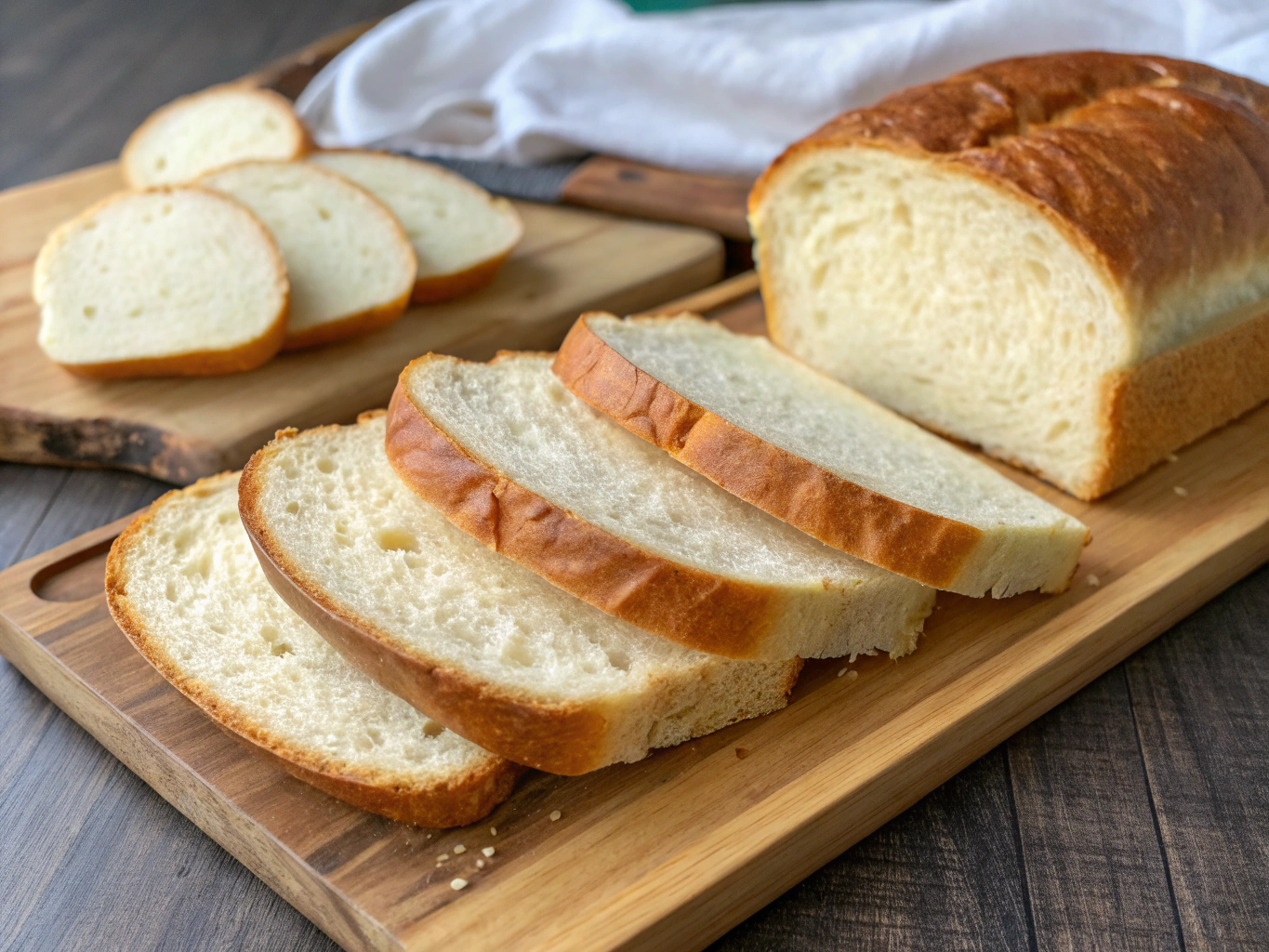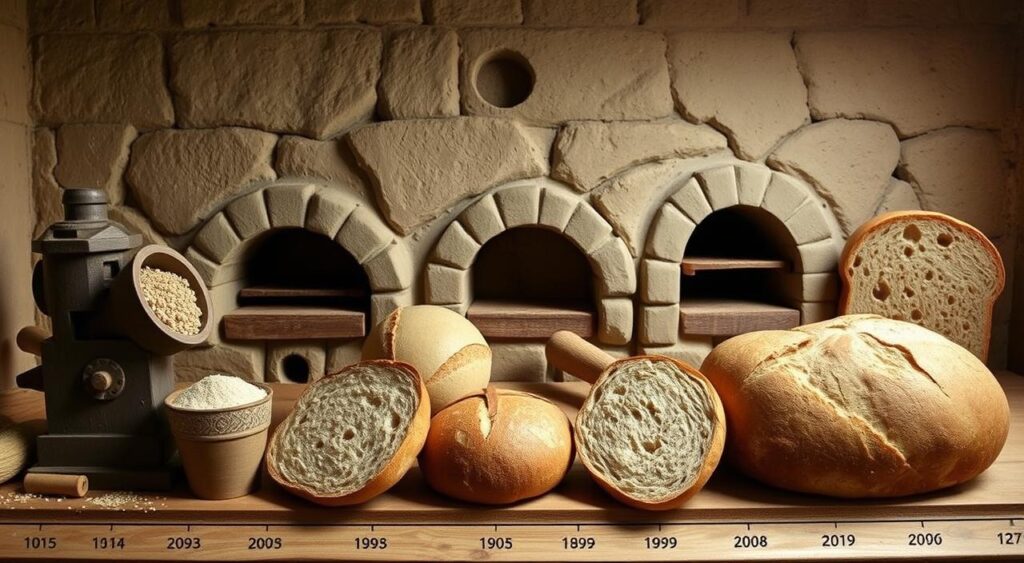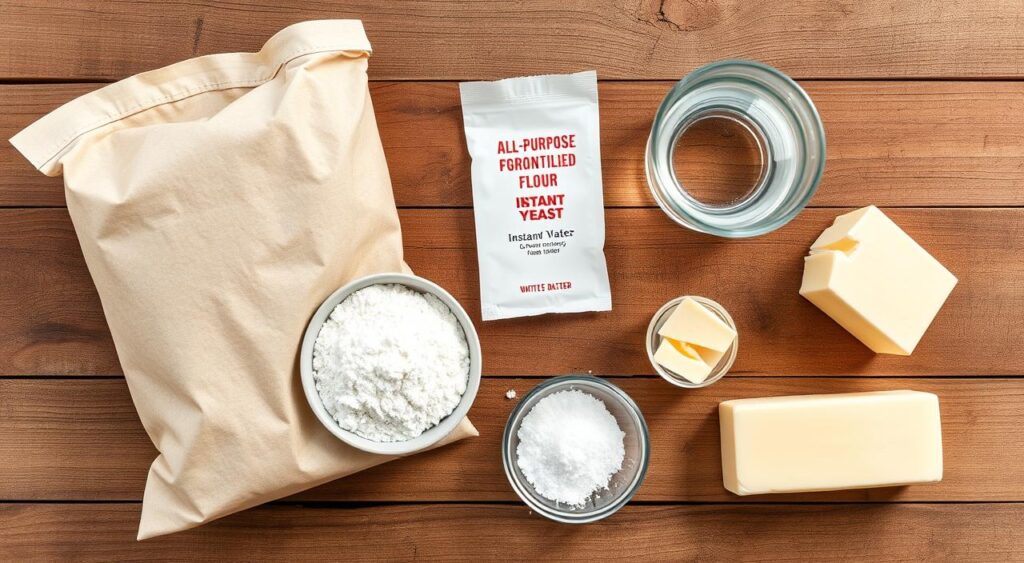Imagine the aroma of freshly baked white bread wafting from your oven, filling your home with warmth and comfort. Baking the best white bread is a skill that can be mastered with the right techniques and ingredients. In this guide, we’ll take you through the process of creating perfect homemade white bread every time, using a simple white bread recipe.
Whether you’re a beginner or an experienced baker, our goal is to provide you with the secrets to making delicious white bread that will become a staple in your household. From understanding the basics of white bread to mastering the techniques for a perfect loaf, we’ll cover it all, including the best white bread recipes and tips for achieving the perfect crust.
With this guide, you’ll be able to create mouthwatering white bread that will impress your family and friends. Our focus is on providing you with a comprehensive guide to baking white bread, including the essential ingredients, tools, and techniques needed to produce a perfect loaf.
Introduction to White Bread Baking
In the following sections, we’ll delve into the world of white bread baking, exploring the history, ingredients, and techniques required to make the best white bread. We’ll also provide you with troubleshooting tips and creative variations to enhance your white bread recipe.
Key Takeaways
- Mastering the art of baking delicious white bread requires the right techniques and ingredients
- A simple white bread recipe can be the foundation for creating a variety of delicious breads
- Understanding the basics of white bread is essential for producing a perfect loaf
- The best white bread recipes often involve a combination of simple ingredients and techniques
- With practice and patience, anyone can become a skilled white bread baker
- Our guide will provide you with the secrets to making the best white bread, including tips for achieving the perfect crust
The History of White Bread
The history of white bread is a long and fascinating one, spanning thousands of years. To understand the origins of white bread, it’s essential to delve into the white bread history and explore how it has evolved over time. From ancient civilizations to modern times, the process of making white bread has undergone significant changes, influenced by technological advancements, cultural exchange, and the availability of ingredients.
As we explore the white bread evolution, we can see that it has been shaped by various factors, including the development of new baking techniques and the introduction of new ingredients. The art of bread-making has been passed down through generations, with each culture adding its unique twist to the traditional recipe.
- The ancient Egyptians, who are credited with being one of the first civilizations to bake bread
- The introduction of yeast, which allowed for the creation of lighter, airier bread
- The development of new baking techniques, such as the use of ovens and mixers
By understanding the white bread history and white bread evolution, we can appreciate the complexity and richness of this staple food. Whether you’re a seasoned baker or just starting out, exploring the history of white bread can inspire new creations and a deeper appreciation for this beloved bread.
Essential Ingredients for White Bread
When it comes to baking delicious white bread, the quality of your ingredients is crucial. The right combination of white bread ingredients can make all the difference in the texture, flavor, and overall appearance of your loaf. At the heart of any good white bread recipe is high-quality white bread flour, which provides the structure and texture that defines this type of bread.
The role of yeast for white bread is also vital, as it is responsible for fermentation, causing the dough to rise and giving the bread its light, airy texture. Understanding how to work with yeast, including how to activate it and how to control the fermentation process, is key to achieving the perfect loaf. Additionally, the importance of salt in white bread recipes should not be overlooked, as it enhances flavor and helps control yeast growth.
Types of Flour
There are several types of flour that can be used to make white bread, each with its own unique characteristics. These include all-purpose flour, bread flour, and cake flour, among others. The choice of flour will depend on the desired texture and flavor of the bread, as well as the level of protein in the flour, which affects the bread’s structure and rise.
Role of Yeast
Yeast is a microorganism that consumes sugars and produces carbon dioxide gas, causing the dough to rise. The type of yeast used can affect the flavor and texture of the bread, with active dry yeast and instant yeast being popular choices for white bread. Proper handling and storage of yeast are essential to ensure it remains active and effective.
Importance of Salt
Salt plays a critical role in white bread recipes, enhancing flavor and controlling yeast growth. It helps to strengthen the gluten structure of the dough, resulting in a better texture and more even crumb. The right amount of salt is essential, as too little can lead to bland flavor, while too much can inhibit yeast activity and affect the rise of the bread.
Tools Needed for Baking White Bread
To bake delicious white bread, having the right tools is essential. With the correct white bread tools and baking equipment for white bread, you can ensure a smooth and successful baking process. The right equipment can make a significant difference in the quality of your bread.
When it comes to baking equipment for white bread, there are some must-have items that every baker should have. These include a mixer, oven, and baking sheets. A mixer can help you mix and knead the dough efficiently, while a good oven is crucial for even baking. Baking sheets are also necessary for shaping and baking the bread.
Must-Have Baking Equipment
- Mixer: for mixing and kneading the dough
- Oven: for baking the bread
- Baking sheets: for shaping and baking the bread
Optional Tools that Make a Difference
In addition to the must-have equipment, there are some optional tools that can enhance your baking experience. These include bread machines and pastry brushes. A bread machine can help you automate the baking process, while a pastry brush can be used to apply egg wash or melted butter to the bread.
By investing in the right white bread tools and baking equipment for white bread, you can take your baking to the next level and produce delicious, high-quality bread.
Step-by-Step Guide to Making White Bread
To start making white bread, it’s essential to follow a simple white bread recipe. Making white bread from scratch can be a fun and rewarding experience, as long as you have the right ingredients and tools. Begin by combining flour, yeast, salt, and sugar in a large mixing bowl. Then, add warm water and mix until a shaggy dough forms.
Next, it’s time to knead the dough. This is a crucial step in making white bread, as it helps to develop the gluten in the dough. Use a stand mixer with a dough hook attachment or knead the dough by hand for 10-15 minutes. As you knead, the dough will start to come together and form a smooth, elastic ball.
Mixing the Dough
- Combine 2 cups of flour, 1 teaspoon of yeast, and 1 teaspoon of salt in a large mixing bowl
- Add 1 tablespoon of sugar and 1 cup of warm water
- Mix until a shaggy dough forms
Kneading Techniques
Kneading the dough is an important step in making white bread. It helps to develop the gluten in the dough, giving the bread its structure and texture. To knead the dough, use a push-down motion with the heel of your hand, followed by a folding motion with your fingers.
Letting It Rise
After kneading the dough, it’s time to let it rise. Place the dough in a greased bowl, cover it with plastic wrap, and let it rise in a warm, draft-free place for 1-2 hours. As the dough rises, it will start to expand and fill with air. This is an essential step in making white bread, as it helps to give the bread its light and airy texture.
| Step | Description |
|---|---|
| 1 | Mixing the dough |
| 2 | Kneading the dough |
| 3 | Letting it rise |
Shaping and Proofing Your Dough
Once you’ve mixed and kneaded your dough, it’s time to shape it into its final form. Shaping white bread is an art that requires some practice, but with a few simple techniques, you can create a beautiful loaf. To start, gently deflate the dough and shape it into a round or oblong loaf. You can also try shaping white bread into a braid or a spiral for a more intricate design.
After shaping, it’s time to proof your dough. Proofing white bread is a critical step that allows the yeast to ferment and the dough to rise. To properly proof your dough, place it in a warm, draft-free area and let it rise for about an hour, or until it has doubled in size. You can also use a proofing basket or a cloth to help the dough hold its shape.
- Use a light touch when shaping the dough to avoid developing the gluten.
- Let the dough proof in a warm, draft-free area to help it rise evenly.
- Don’t overproof the dough, as this can cause it to collapse or become dense.
By following these tips and practicing your shaping and proofing techniques, you can create a beautiful, delicious loaf of white bread that’s perfect for sandwiches, toast, or just snacking on its own.
| Shaping Technique | Proofing Time | Result |
|---|---|---|
| Round loaf | 1 hour | Classic, symmetrical loaf |
| Braided loaf | 1.5 hours | Beautiful, intricate design |
| Spiral loaf | 2 hours | Unique, eye-catching shape |
Baking Your White Bread
When it comes to baking white bread, the oven temperature and timing are crucial for achieving the perfect loaf. The ideal white bread oven temperature is between 350°F and 400°F, depending on the type of oven and the size of the loaf. To ensure that your bread is baked to perfection, it’s essential to monitor the temperature and adjust the baking time accordingly.
For a golden, crispy crust, it’s recommended to bake the bread at a higher temperature for a shorter amount of time. This will help to create a crust that is crunchy on the outside and soft on the inside. When baking white bread, it’s also important to keep an eye on the bread’s progress, as the baking time may vary depending on the size and shape of the loaf.
Oven Temperature and Timing
To achieve the perfect bake, follow these guidelines for baking white bread:
- Preheat the oven to 375°F for a standard-sized loaf
- Bake for 25-35 minutes, or until the bread is golden brown and sounds hollow when tapped on the bottom
- For a smaller loaf, bake at 400°F for 15-20 minutes
By following these tips and using the right white bread oven temperature, you’ll be able to create delicious, freshly baked white bread that’s perfect for sandwiches, toast, or just snacking on its own. Whether you’re a seasoned baker or just starting out, baking white bread is a rewarding process that requires attention to detail and a bit of practice.
Troubleshooting Common White Bread Issues
When baking white bread, it’s not uncommon to encounter problems that can affect the final product’s texture and appearance. Troubleshooting white bread issues requires identifying the root cause of the problem and taking corrective action. One of the most common white bread problems is a dense or heavy loaf, which can be caused by overmixing the dough or using too much yeast.
To overcome this issue, it’s essential to understand the importance of proper mixing and yeast usage. Here are some tips to help you troubleshoot white bread issues:
- Check your yeast expiration date to ensure it’s still active
- Use the right amount of yeast for your recipe
- Mix your dough just until the ingredients come together in a shaggy mass
- Avoid overmixing, as this can lead to a dense and heavy loaf
Another common issue is an uneven crust, which can be caused by uneven oven temperature or inadequate steam. To achieve a perfectly baked crust, make sure to:
Use a thermometer to ensure your oven is at the correct temperature
By following these tips and understanding the common white bread problems, you’ll be well on your way to baking delicious and perfectly textured white bread. Remember to always keep an eye on your dough and loaf during the baking process, and don’t hesitate to experiment and try new things to troubleshoot white bread issues and achieve the perfect loaf.
| Common White Bread Issues | Cause | Solution |
|---|---|---|
| Dense or Heavy Loaf | Overmixing or too much yeast | Proper mixing and yeast usage |
| Uneven Crust | Uneven oven temperature or inadequate steam | Use thermometer and baking stone or steam injection |
Creative Variations on Classic White Bread
Experimenting with white bread variations can be a great way to add some excitement to your baking routine. By incorporating different ingredients into your dough, you can create unique and delicious flavors that will elevate your white bread game. One way to do this is by adding herbs and spices, such as garlic, rosemary, or thyme, to give your bread a savory twist.
Another option is to incorporate seeds or nuts into your dough, which can add texture and flavor to your bread. Some popular choices include sunflower seeds, walnuts, or pumpkin seeds. Here are a few ideas to get you started:
- Garlic and rosemary: Mix minced garlic and chopped rosemary into your dough for a flavorful and aromatic bread.
- Sunflower seeds: Add some sunflower seeds to your dough for a nutty and crunchy texture.
- Cinnamon and raisin: Mix in some cinnamon and raisins for a sweet and spicy bread.
These creative white bread variations can be a great way to mix things up and try new flavors. Whether you’re a seasoned baker or just starting out, experimenting with different ingredients can be a fun and rewarding experience. So why not give it a try and see what delicious creations you can come up with?
With a little creativity, you can turn a classic white bread into a truly unique and delicious treat. So go ahead, get baking, and see what amazing white bread variations you can create!
| Ingredient | Flavor Profile | Texture |
|---|---|---|
| Garlic and rosemary | Savory and aromatic | Soft and fluffy |
| Sunflower seeds | Nutty and crunchy | Crunchy and chewy |
| Cinnamon and raisin | Sweet and spicy | Soft and sweet |
Storing and Enjoying Fresh White Bread
Now that you’ve mastered the art of baking delicious white bread, it’s time to learn how to properly store and enjoy your fresh-from-the-oven creation. Proper storage is key to keeping your bread at its best, and there are a few simple tips to follow.
Best Storage Practices
To preserve the texture and flavor of your white bread, store it at room temperature in a paper or cloth bag. Avoid plastic bags, as they can trap moisture and lead to premature staleness. For longer-term storage, you can slice the bread and freeze it, which will help maintain its freshness for up to three months.
Delicious Serving Suggestions
Once you’ve mastered the storing white bread, it’s time to explore the many ways you can enjoy your homemade loaf. From classic sandwiches to tasty croutons and decadent bread pudding, the possibilities are endless. Pair your white bread with your favorite deli meats, cheeses, or even use it as the base for French toast for a delightful breakfast treat.
Whether you’re savoring a simple slice with butter or incorporating it into your favorite recipes, your freshly baked white bread is sure to bring joy to your table. Embrace the art of serving white bread and delight your family and friends with your baking prowess.
FAQ
What is the best white bread?
The best white bread is a matter of personal preference, but some of the most popular and highly-rated white bread brands include Pepperidge Farm, Sara Lee, and Nature’s Own. When choosing a white bread, look for one that is soft, fluffy, and has a nice golden crust.
Where can I buy white bread?
White bread is widely available at most grocery stores, supermarkets, and even some convenience stores. You can also purchase white bread online from various retailers, such as Amazon, Walmart, or specialty bakery websites.
How do I make white bread at home?
Making white bread at home is relatively easy and requires just a few basic ingredients: all-purpose flour, yeast, water, salt, and sometimes butter or milk. The key steps include mixing the dough, kneading, proofing, and baking in the oven. Follow a reliable white bread recipe for best results.
What are the benefits of white bread?
While whole wheat bread is often considered healthier, white bread can still be part of a balanced diet. White bread is a good source of carbohydrates, which provide energy, and it is often fortified with essential vitamins and minerals. However, it is generally lower in fiber compared to whole grain options.
What is the nutrition of white bread?
A typical slice of white bread contains approximately 75-100 calories, 1-2 grams of fat, 15-20 grams of carbohydrates, and 2-3 grams of protein. The exact nutritional values can vary depending on the brand and recipe used.
What are the best white bread brands?
Some of the top-rated and most popular white bread brands include Pepperidge Farm, Sara Lee, Nature’s Own, Oroweat, and Bimbo. These brands are known for their soft, fluffy texture and consistent quality.
How does white bread differ from wheat bread?
The main difference between white bread and wheat bread is the type of flour used. White bread is made with refined white flour, which has had the bran and germ removed, resulting in a softer, lighter texture. Wheat bread, on the other hand, is made with whole wheat flour, which includes the bran and germ, making it more nutritious but with a denser, heartier texture.





